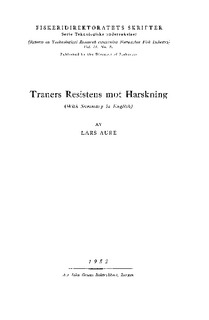| dc.description | Determination of the peroxides formed during blowing with air or
oxygen at room temperature has been regarded as the best method for
testing the stability of fat oils, and especially for determination of their
induction periods.
The present investigations are chiefly dealing with airblowing of
medicinal cod liver oils, to find if a more rapid stability test can be obtained for these oils by elevation of the reaction temperature.
The results can be summarized as follows:
1. The oils were treated with air in an apparatus permitting controlled
temperature and airstream conditions (fig. 1).
2. No reaction products with prooxidativ effect were blown off the
oils with the airstream at a temperature of 40° C. Diffuse daylight,
the humidity of the air, or filtering of the oils, were all factors of
minor importance.
3. Increase in the airstream increased the rate of peroxidation considerably, but to a very different degree in different cod liver oils.
In relation to calculated zero peroxide numbers (airstream->O),
the blowing with 50 l-air per hour at 40° C through 30 g oil, increased
the rate of peroxidation from 50,5 to 113,5 °/o. The stability test
therefore must be carried out with minimum airstream. 5 l air per
hour through 30 g oil was found to give relatively small errors,
and at the same time sufficient stirring of the oils.
4. For resistent oils the absorbtion of oxygen per hour increased with
the time. Destearinized oils, on the other hand, showed no induction period, and a slight decrease in the rate of peroxidation with
the time took place.
5. The temperature coefficients of the resistant oils showed no relation
to the temperature or the blowing time, but changed extremely
irregular. For the destearinized oils these coefficients showed considerable constancy, averaging 1,71 from 19° C and upwards to 70° C.
6. The reliable stability relations of the steam rendered cod liver oils,
expressed as quotients of the increase in their peroxide numbers
after airblowing at 20° C for 72 hours, equalled the stability relations
found by blowing at 60° C for 3 hours. This was especially true for
the destearinized oils. No other blowing time at any elevated temperatures up to 70° C gave these stability relations.
7. By destearination of the oils the antioxidants were filtered off with
the stearin - this -was also the case with the bulk of the oil components containing phosphorus. This indicates that the antioxidants
in unstearinized cod liver oils are mainly phosphatides.
8. The antioxidants in unstearinized oils were destroyed in about 1/2
hour by 100° C.
9. Washing with destilled water increased the stability.
10. In a liver oil, stored airtight for half a year, the decomposition of
peroxides and the formation of epihydrinaldehyd (Kreistest)
approximately paralleled each other.
11. Unstearinized oils, produced by centrifugal methods from the fresh
residues of steamheated cod livers, had much lower resistance to
oxidation than the corresponding steam rendered oils. | no_NO |
